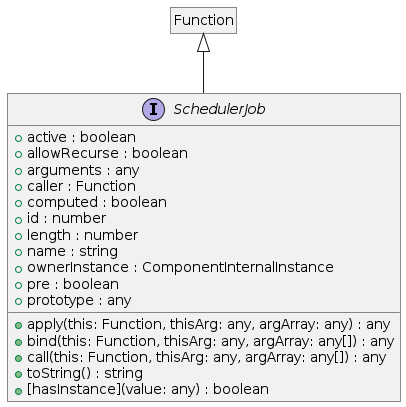Interface SchedulerJob
active?: boolean;
allowRecurse?: boolean;
arguments: any;
caller: Function;
computed?: boolean;
id?: number;
length: number;
name: string;
ownerInstance?: ComponentInternalInstance;
pre?: boolean;
prototype: any;
[hasInstance](value: any): boolean;
apply(this: Function, thisArg: any, argArray?: any): any;
bind(this: Function, thisArg: any, ...argArray: any[]): any;
call(this: Function, thisArg: any, ...argArray: any[]): any;
toString(): string;
}
Hierarchy-Diagram

Legend
Hierarchy
- Function
- SchedulerJob
Properties
Optional active
Optional allow
arguments
caller
Optional computed
Optional id
Readonly length
Readonly name
Returns the name of the function. Function names are read-only and can not be changed.
Optional owner
Attached by renderer.ts when setting up a component's render effect Used to obtain component information when reporting max recursive updates. dev only.
Optional pre
prototype
Methods
[has
- [has
Instance](value: any): boolean Determines whether the given value inherits from this function if this function was used as a constructor function.
A constructor function can control which objects are recognized as its instances by 'instanceof' by overriding this method.
Parameters
- value: any
Returns boolean
apply
- apply(this: Function, thisArg: any, argArray?: any): any
Calls the function, substituting the specified object for the this value of the function, and the specified array for the arguments of the function.
Parameters
- this: Function
- thisArg: any
The object to be used as the this object.
OptionalargArray: anyA set of arguments to be passed to the function.
Returns any
bind
- bind(this: Function, thisArg: any, ...argArray: any[]): any
For a given function, creates a bound function that has the same body as the original function. The this object of the bound function is associated with the specified object, and has the specified initial parameters.
Parameters
- this: Function
- thisArg: any
An object to which the this keyword can refer inside the new function.
Rest...argArray: any[]A list of arguments to be passed to the new function.
Returns any
call
- call(this: Function, thisArg: any, ...argArray: any[]): any
Calls a method of an object, substituting another object for the current object.
Parameters
- this: Function
- thisArg: any
The object to be used as the current object.
Rest...argArray: any[]A list of arguments to be passed to the method.
Returns any
Indicates whether the effect is allowed to recursively trigger itself when managed by the scheduler.
By default, a job cannot trigger itself because some built-in method calls, e.g. Array.prototype.push actually performs reads as well (#1740) which can lead to confusing infinite loops. The allowed cases are component update functions and watch callbacks. Component update functions may update child component props, which in turn trigger flush: "pre" watch callbacks that mutates state that the parent relies on (#1801). Watch callbacks doesn't track its dependencies so if it triggers itself again, it's likely intentional and it is the user's responsibility to perform recursive state mutation that eventually stabilizes (#1727).